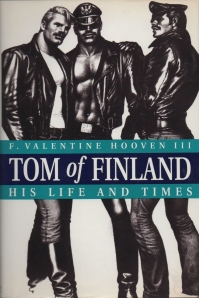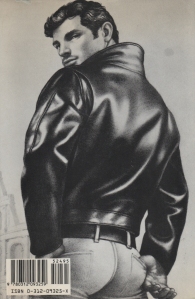First Pages: Tom of Finland biography by F. Valentine Hooven III
Welcome to First Pages on Fridays! On Fridays, we share the first pages from a book (usually vintage), along with a bit of information about the author and the book’s history.
This week’s excerpt is from Tom of Finland: His Life and Times by F. Valentine Hooven III. The book was published in 1993 by St. Martin’s Press (not too shabby), and it’s a biography of the Finnish artist Tuoko Laaksonen (aka, Tom of Finland). If you’re not familiar with his work, you really should take a second and look him up. His illustrations of burly, muscular, leather-clad, well-endowed men are sexy, sometimes scandalous, and often a bit ridiculous, too; and they became iconic almost as soon as they began appearing in the 1970’s.
Hooven, the author, worked closely with Tom of Finland in the last few years of his life to write this biography, so it’s not exactly an objective look at his life and work. But it’s still pretty darn interesting.
Here are the first pages. Enjoy!
Chapter 1
“Tom of Finland,” the foremost name in gay erotic art, is not a pseudonym. Touko Laaksonen, the man who would become known by that name, was born in Finland on May 8, 1920. He was named for the month in which he was born (“May” in Finnish is toukokuu) and “Tom” sounds more like “Touko” than any other English name, so “Tom of Finland” really is Tom of Finland.
Though small in population, Finland is one of the bigger European countries in size, being larger than New York and the six New England states combined. Its shape is a lot like an upside-down Italy with the boot portion projecting into the Arctic Circle. Tom’s birthplace was Kaarina, at the southwestern tip of the country, where the Baltic Sea divides into two arms, one stretching north between Finland and Sweden, the other one reaching east to Russia. Kaarina is near Turku, the ancient capital of Finland. The modern seaport of Turku has grown so much since Tom’s birth that Kaarina is now a sprawl of suburbs, but back in the twenties the neighborhood where Tom grew up was more country than town, a checkerboard of fields of wheat and rye alternating with woods of fir and birch.
Fields meant farmers and woods meant lumberjacks. From the start, Tom lived among the kind of men he would never tire of depicting in his art. Even in his early childhood, Tom’s eye began to store up images of those well-muscled laborers: how their mouths looked when they shouted or laughed; how their sweat-stained leather pants wrinkled at the crotch; how they swung their muddy boots out to the sides when they walked.
He also absorbed the sort of detail that could not be pictured directly: how they chose their clothing without any concern for appearance, wearing boots and leather simply because these were practical for outdoor work. If fashion was mentioned, they shook their heads and sneered or laughed. Tom remembered how they looked then, too.
Those Finnish country boys were no different from the youths of any time or place: full of animal high spirits. In spite of long days of hard manual labor, they always seemed to have enough energy left over to tussle and wrestle with their buddies. They liked to strip off their shirts at the first hint of sunshine and work with their bare torsos gleaming with sweat.
I can remember my first infatuation for one of those guys. He was a young field hand whose farm was near our house. He was short but very muscular and his name, Urho, was very appropriate because it means “hero” in Finnish. Although I didn’t have the foggiest idea then why I was so fascinated with him, I can remember hiding in the bushes on summer afternoons to watch him, naked to the waist, working in the wheat.
These were the men Tom would draw for the rest of his life: big, uncomplicated, physically oriented men, proud of their muscles and even prouder of their cocks, easily aroused, whether to anger or to lust, but also–and this is important–easy to please and quick to forgive, always ready with a hand-clasp and an embrace.
These are real men, men’s men, Tom’s men.
Years later, the memories–the way one man’s hand sat on his neck, the way the waistband of another man’s pants rode low on the tops of his buttocks–would come tumbling out of Tom’s pencil almost of their own accord.
Both of Tom’s parents were schoolteachers, who staffed the little grammar school that served Kaarina. The family, including one of Tom’s grandmothers, lived in the school building itself, which had living quarters for the teachers attached to the back. With an ample yard for making snowmen in winter or catching fireflies in summer, it was an excellent place for raising children. There Tom, his older brother, and his three sisters (two older and one younger) grew up.
Though his parents, particularly his father, were strict, they were far from harsh. As might be expected in a family headed by two teachers, Tom’s home life was heavy on culture. He and his siblings grew up steeped in the arts. Even their play involved music, art, theater, literature. Those are subjects not usually found in children’s games. Many a boy would have spent such a childhood moaning and squirming, but Tom loved it. He quickly established himself as a child of many talents, especially adept at playing the piano.
Athletics never held his attention much, not at any age of his life, but the athletes themselves did. His favorite athletes were soccer players in their tight shorts and form-fitting jerseys.
I was always attracted to the men of action. My father was not a real man in my eyes, though he was really very handsome–and very well hung–but he wore a white collar and worked indoors, using his mind rather than his body, so he didn’t have the appeal of a soldier or a policeman.
Tom loved best of all to draw pictures. In mild weather, he hunched over a table on the summer porch, executing one drawing after another. When winter came and the temperature dropped, he would move inside next to the hulking ceramic stove, which radiated heat for hours on one little load of wood, giving him time enough to create a whole art gallery.
He was especially attracted to the comic-strip format. It enabled him to practice several of his talents at the same time, since the humble art of the comic book required multiple abilities, not only visual but dramatic and literary as well.
The oldest extant work by Tom of Finland, done when he was five and a half or six, is a comic book, the tale of a boy who lives in the glamorous big city. It features buses and fashionably dressed stick figures. At the end of the story, big strong policemen come and save the boy and his family from their troubles. Tom confessed that most of his strip was blatantly plagiarized from comics of the time, but it nonetheless showed remarkable ingenuity for a child of that age.
I like the comic-book format because I can show what is happening between two guys, not just how they look. Even when I am doing a drawing that is not a part of a series, I try to draw it so that the onlooker can tell, by the gestures and by the expressions on the faces, what has already happened and what is going to happen next.
There was no doubt that the solemn-faced little Tom was an ingenious boy. Even he knew it, and he had big dreams. He was going to be a great artist–or maybe a concert pianist.
—–
For more information about Tom of Finland, visit the Tom of Finland Foundation.
And don’t forget to visit the Somewhere Books online shop!
2 responses to “First Pages: Tom of Finland biography by F. Valentine Hooven III”
Trackbacks / Pingbacks
- - May 2, 2014



Check out the NEW edition of this biography! http://www.worldoftomoffinland.com/tomsblog/?tag=tom-biography